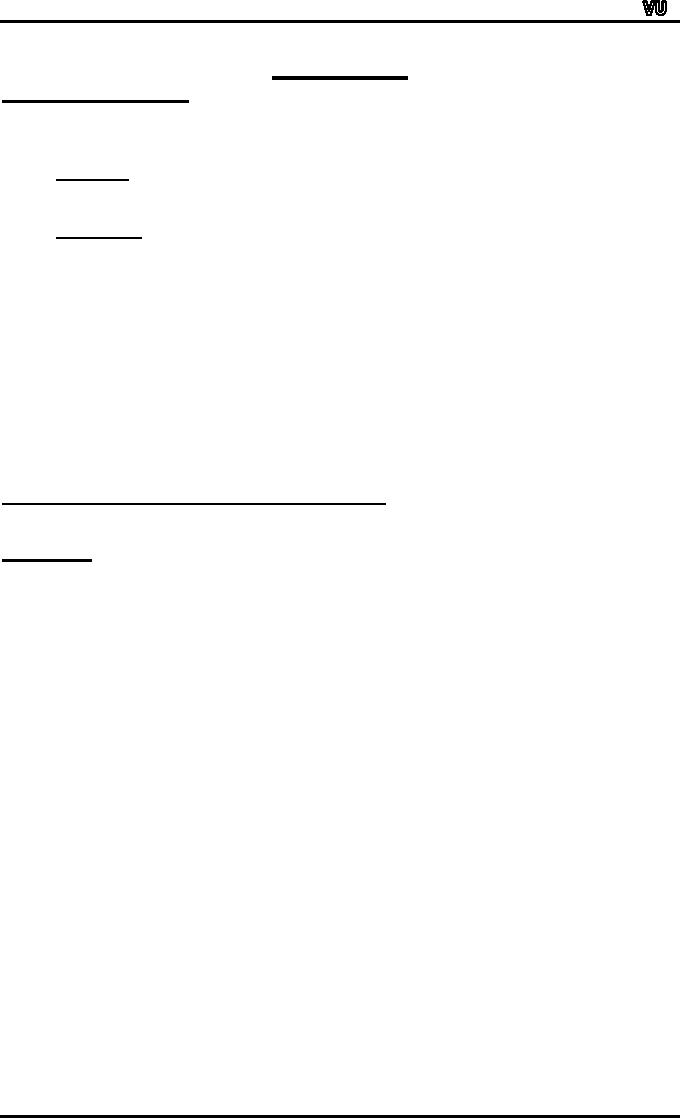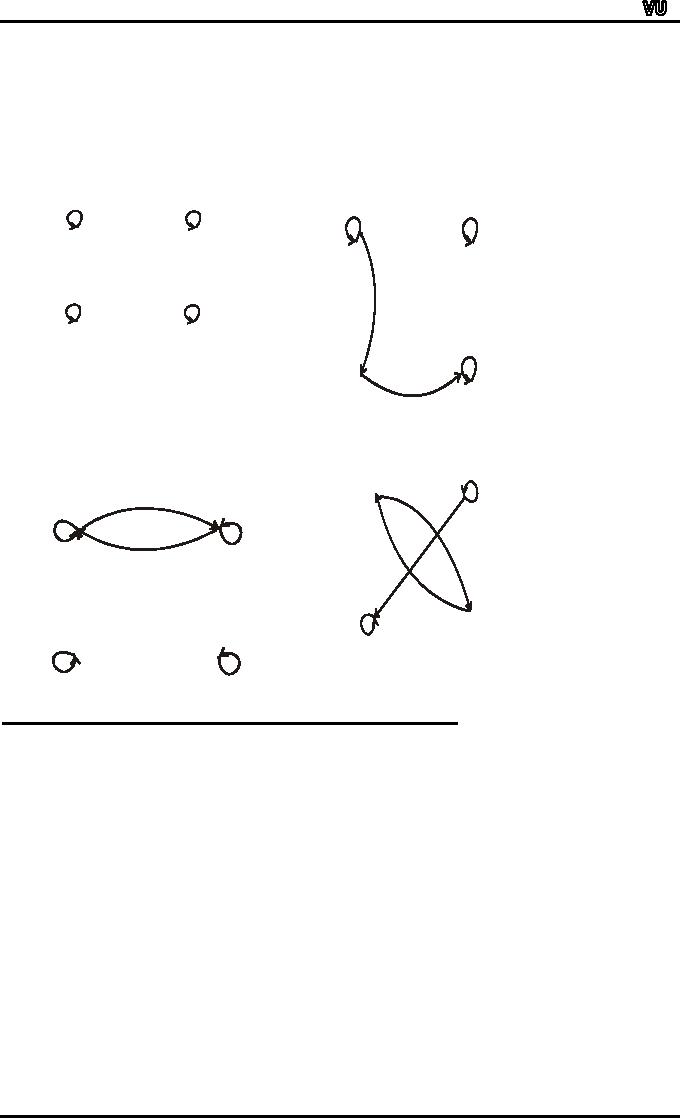 |
REFLEXIVE RELATION:SYMMETRIC RELATION, TRANSITIVE RELATION |
| << ORDERED PAIR:BINARY RELATION, BINARY RELATION |
| REFLEXIVE RELATION:IRREFLEXIVE RELATION, ANTISYMMETRIC RELATION >> |

MTH001
Elementary Mathematics
LECTURE #
9
REFLEXIVE
RELATION:
Let R be a
relation on a set A. R is reflexive
if, and only if,
for all a ∈
A,
(a, a)
∈R.
Or equivalently aRa.
That
is, each element of A is
related to itself.
REMARK
R
is not reflexive iff there
is an element "a" in A such
that
(a,
a) ∉R.
That is, some element
"a" of A is not
related
to itself.
EXAMPLE:
Let
A = {1, 2, 3, 4} and define
relations R1,R2,
R3, R4
on
A
as
follows:
R1 =
{(1, 1), (3, 3),
(2, 2), (4,
4)}
R2 =
{(1, 1), (1, 4),
(2, 2), (3, 3),
(4, 3)}
R3 =
{(1, 1), (1, 2),
(2, 1), (2, 2),
(3, 3), (4,
4)}
R4 =
{(1, 3), (2, 2),
(2, 4), (3, 1),
(4, 4)}
Then,
R1 is
reflexive, since (a, a)
∈R1
for all a ∈A.
R2 is
not reflexive, because (4,
4) ∉R2.
R3 is
reflexive, since (a, a)
∈R3
for all a ∈A.
R4 is
not reflexive, because (1,
1) ∉R4,
(3, 3) ∉R4
DIRECTED
GRAPH OF A REFLEXIVE
RELATION:
The
directed graph of every
reflexive relation includes an
arrow from every point
to
the
point itself (i.e., a
loop).
EXAMPLE
:
Let
A = {1, 2, 3, 4} and define
relations R1,
R2, R3, and
R4
on
A by
Page
42

MTH001
Elementary Mathematics
R1 =
{(1, 1), (3, 3),
(2, 2), (4,
4)}
R2 =
{(1, 1), (1, 4),
(2, 2), (3, 3),
(4, 3)}
R3 =
{(1, 1), (1, 2),
(2, 1), (2, 2),
(3, 3), (4,
4)}
R4 =
{(1, 3), (2, 2),
(2, 4),
(3,
1), (4, 4)}
Then
their directed graphs
are
1
2
1
2
4
3
R1 is
reflexive because at
4
3
every
point of the set A we
have
a loop in the graph.
R2 is
not reflexive, as there
is
no loop at 4.
1
2
1
2
4
3
3
4
R4 is
not reflexive, as there
are
R3 is
reflexive
no
loops at 1and 3.
MATRIX
REPRESENTATION OF A REFLEXIVE
RELATION:
Let
A = {a1,
a2, ..., an}. A
Relation R on A is reflexive if and
only if
(ai,
aj) ∈R ∀
i=1,2,
...,n.
Accordingly,
R is reflexive
if all
the elements on the
main
diagonal of
the
matrix
M
representing R
are equal to 1.
EXAMPLE:
The
relation R = {(1,1), (1,3),
(2,2), (3,2), (3,3)} on A =
{1,2,3}
represented
by the following matrix M,
is
reflexive.
1 2 3
1
⎡1
0 1⎤
M
=
2
⎢0
1 0⎥
⎢
⎥
3
⎢0
1 1⎥
⎣
⎦
SYMMETRIC
RELATION
Let
R be a relation on a set A. R is
symmetric if, and only
if,
for
all a, b ∈
A, if
(a, b) ∈R then
(b, a) ∈R.
That
is, if aRb then
bRa.
Page
43

MTH001
Elementary Mathematics
REMARK
R
is not symmetric iff there
are elements a
and
b
in A such
that
(a,
b)
∈R
but (b, a) ∉R.
EXAMPLE
Let
A = {1, 2, 3, 4} and define
relations R1,
R2, R3, and R4on A
as
follows.
R1 =
{(1, 1), (1, 3),
(2, 4), (3, 1),
(4,2)}
R2 =
{(1, 1), (2, 2),
(3, 3), (4,
4)}
R3 =
{(2, 2), (2, 3),
(3, 4)}
R4 =
{(1, 1), (2, 2),
(3, 3), (4, 3),
(4, 4)}
Then
R1 is
symmetric because for every
order pair (a,b)in R1awe have (b,a)
in
R1for example we have
(1,3)in R1
the we
have (3,1) in R1 similarly all
other
ordered
pairs can be
cheacked.
R2 is
also symmetric symmetric we
say it is vacuously
true.
R3 is
not symmetric, because (2,3)
∈ R3 but (3,2) ∉
R3.
R4 is
not symmetric because (4,3)
∈ R4 but (3,4) ∉
R4.
DIRECTED
GRAPH OF A SYMMETRIC
RELATION
For
a symmetric directed graph
whenever there is an
arrow
going
from one
point
of
the graph to a second, there
is an arrow going from the
second point back to
the
first.
EXAMPLE
Let
A = {1, 2, 3, 4} and define
relations R1,
R2, R3, and R4 on
A
by the directed
graphs:
R1 =
{(1, 1), (1, 3),
(2, 4), (3, 1),
(4,2)}
R2 =
{(1, 1), (2, 2),
(3, 3), (4,
4)}
R3 =
{(2, 2), (2, 3),
(3, 4)}
R4=
{(1, 1), (2, 2),
(3, 3), (4, 3),
(4, 4)}
Page
44
Table of Contents:
- Recommended Books:Set of Integers, SYMBOLIC REPRESENTATION
- Truth Tables for:DE MORGAN’S LAWS, TAUTOLOGY
- APPLYING LAWS OF LOGIC:TRANSLATING ENGLISH SENTENCES TO SYMBOLS
- BICONDITIONAL:LOGICAL EQUIVALENCE INVOLVING BICONDITIONAL
- BICONDITIONAL:ARGUMENT, VALID AND INVALID ARGUMENT
- BICONDITIONAL:TABULAR FORM, SUBSET, EQUAL SETS
- BICONDITIONAL:UNION, VENN DIAGRAM FOR UNION
- ORDERED PAIR:BINARY RELATION, BINARY RELATION
- REFLEXIVE RELATION:SYMMETRIC RELATION, TRANSITIVE RELATION
- REFLEXIVE RELATION:IRREFLEXIVE RELATION, ANTISYMMETRIC RELATION
- RELATIONS AND FUNCTIONS:FUNCTIONS AND NONFUNCTIONS
- INJECTIVE FUNCTION or ONE-TO-ONE FUNCTION:FUNCTION NOT ONTO
- SEQUENCE:ARITHMETIC SEQUENCE, GEOMETRIC SEQUENCE:
- SERIES:SUMMATION NOTATION, COMPUTING SUMMATIONS:
- Applications of Basic Mathematics Part 1:BASIC ARITHMETIC OPERATIONS
- Applications of Basic Mathematics Part 4:PERCENTAGE CHANGE
- Applications of Basic Mathematics Part 5:DECREASE IN RATE
- Applications of Basic Mathematics:NOTATIONS, ACCUMULATED VALUE
- Matrix and its dimension Types of matrix:TYPICAL APPLICATIONS
- MATRICES:Matrix Representation, ADDITION AND SUBTRACTION OF MATRICES
- RATIO AND PROPORTION MERCHANDISING:Punch recipe, PROPORTION
- WHAT IS STATISTICS?:CHARACTERISTICS OF THE SCIENCE OF STATISTICS
- WHAT IS STATISTICS?:COMPONENT BAR CHAR, MULTIPLE BAR CHART
- WHAT IS STATISTICS?:DESIRABLE PROPERTIES OF THE MODE, THE ARITHMETIC MEAN
- Median in Case of a Frequency Distribution of a Continuous Variable
- GEOMETRIC MEAN:HARMONIC MEAN, MID-QUARTILE RANGE
- GEOMETRIC MEAN:Number of Pupils, QUARTILE DEVIATION:
- GEOMETRIC MEAN:MEAN DEVIATION FOR GROUPED DATA
- COUNTING RULES:RULE OF PERMUTATION, RULE OF COMBINATION
- Definitions of Probability:MUTUALLY EXCLUSIVE EVENTS, Venn Diagram
- THE RELATIVE FREQUENCY DEFINITION OF PROBABILITY:ADDITION LAW
- THE RELATIVE FREQUENCY DEFINITION OF PROBABILITY:INDEPENDENT EVENTS